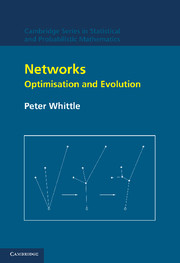Book contents
- Frontmatter
- Contents
- Acknowledgements
- Conventions on notation
- Tour d'Horizon
- Part I Distributional networks
- Part II Artificial neural networks
- Part III Processing networks
- Part IV Communication networks
- Appendix 1 Spatial integrals for the telephone problem
- Appendix 2 Bandit and tax processes
- Appendix 3 Random graphs and polymer models
- References
- Index
Part III - Processing networks
Published online by Cambridge University Press: 23 November 2009
- Frontmatter
- Contents
- Acknowledgements
- Conventions on notation
- Tour d'Horizon
- Part I Distributional networks
- Part II Artificial neural networks
- Part III Processing networks
- Part IV Communication networks
- Appendix 1 Spatial integrals for the telephone problem
- Appendix 2 Bandit and tax processes
- Appendix 3 Random graphs and polymer models
- References
- Index
Summary
By ‘processing’ we mean ‘industrial processing’, often referred to more restrictively as job-shop scheduling. Although this may be computerised, we shall not stray into the profoundly specialised and developed fields of computer processing or computer networks.
We are then concerned with the situation in which items under manufacture undergo a sequence of processing operations before they are completed. The aim is then to so schedule these that congestion at any part of the processing line is avoided, by the optimal allocation of fixed or mobile capacity.
This application does not constitute such a strong example of network optimisation, because the fact that the sequence of operations is prescribed means that the form of the network is both simple and largely preordained. Nevertheless, the application is one that in fact generated the concept of a queueing network, and raises the question of the prioritisation of competing flows.
Even here we need something of a disclaimer. The subject of scheduling is a strongly developed one in its own right, founded on both empirical experience and theoretical investigation, and to step in claiming insight would be the highest presumption. Nevertheless, the subject has itself generated at least two discernable bodies of fundamental theory. One is that which views manufacture as a queueing network, to be optimised in operation by appropriate state-dependent rules, with design optimisation then following. There are difficulties, not least those of local versus central implementation, and the possibly dire effects of misconceived priority rules.
- Type
- Chapter
- Information
- NetworksOptimisation and Evolution, pp. 167 - 168Publisher: Cambridge University PressPrint publication year: 2007

